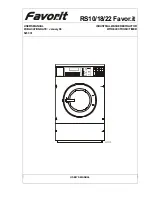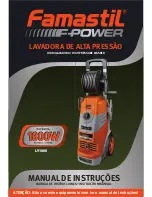
4
Drain System
The washer/dryer can be installed using the standpipe drain
system (floor or wall), the laundry tub drain system, or the floor
drain system. Select the drain hose installation method you need.
See “Alternate Parts.”
Standpipe drain system - wall or floor (views A & B)
The standpipe drain requires a minimum diameter standpipe of
2" (5 cm). The minimum carry-away capacity can be no less than
17 gal. (64 L) per minute. A 2" (5 cm) diameter to 1" (2.5 cm)
diameter standpipe adapter kit is available. See “Alternate Parts.”
The top of the standpipe must be at least 39" (99 cm) high and no
higher than 96" (2.4 m) from the bottom of the washer.
Laundry tub drain system (view C)
The laundry tub needs a minimum 20 gal. (76 L) capacity. The top
of the laundry tub must be at least 34" (86.4 cm) above the floor
and no higher than 96" (2.4 m) from the bottom of the washer.
Floor drain system (view D)
The floor drain system requires a siphon break that may be
purchased separately. See “Alternate Parts.”
The siphon break must be a minimum of 28" (71 cm) from the
bottom of the washer. Additional hoses might be needed.
Electrical Requirements
It is your responsibility
■
To contact a qualified electrical installer.
■
To be sure that the electrical connection is adequate and in
conformance with the National Electrical Code, ANSI/NFPA
70-latest edition and all local codes and ordinances.
A copy of the above code standards can be obtained from:
National Fire Protection Association, One Batterymarch Park,
Quincy, MA 02269.
■
To supply the required 3 or 4 wire, single phase, 120/240-volt,
60-Hz., AC-only electrical supply (or 3 or 4 wire, 120/208-volt
electrical supply, if specified on the serial/rating plate) on a
separate 30-amp circuit, fused on both sides of the line. A
time-delay fuse or circuit breaker is recommended. Connect
to an individual branch circuit. Do not have a fuse in the
neutral or grounding circuit.
■
Do not use an extension cord.
■
If codes permit and a separate ground wire is used, it is
recommended that a qualified electrician determine that the
ground path is adequate.
Electrical Connection
To properly install your washer/dryer, you must determine the type
of electrical connection you will be using and follow the
instructions provided for it here.
■
This dryer is manufactured ready to install with a 3-wire
electrical supply connection. The green cabinet-grounding
conductor is permanently connected to the neutral conductor
(white wire) within the dryer. If the dryer is installed with a
4-wire electrical supply connection, the green cabinet-
grounding conductor must be removed from the external
ground connector (green screw), and secured under the
neutral terminal (center or white wire) of the terminal block.
When the green cabinet-grounding conductor is secured
under the neutral terminal (center or white wire) of the terminal
block, the dryer cabinet is isolated from the neutral conductor.
■
If local codes do not permit the connection of a cabinet
ground connector to the neutral wire, see “Optional 3-wire
connection” section.
■
Use a 4-wire conductor cord when the dryer is installed in a
mobile home or an area where local codes do not permit
grounding through the neutral.
If using a power supply cord:
Use a UL listed power supply cord kit marked for use with clothes
dryers. The kit should contain:
■
A UL listed 30-amp power supply cord, rated 120/240 volt
minimum. The cord should be type SRD or SRDT and be at
least 4 ft (1.22 m) long. The wires that connect to the dryer
must end in ring terminals or spade terminals with upturned
ends.
■
A UL listed strain relief.
39"
(99 cm)
A
B
D
C
34"
(86.4 cm)


































